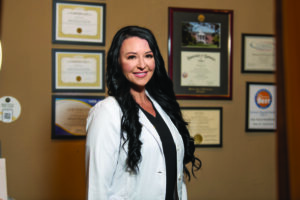Feeling is a Big Part of Healing
Toni Frugé was originally diagnosed with invasive ductal carcinoma in 2017 at the young age of 38. After radiation and chemotherapy treatment, she found herself in a continuous cycle of monitoring, during which she felt like she was just waiting for the cancer to come back. In 2019, after a self-exam, Toni discovered a lump and received a devastating diagnosis of stage IV breast cancer. “I was living in fear and wanted my life back from cancer, so I considered a double mastectomy. I was reluctant, though, because a friend had been through that surgery and experienced permanent numbness in her chest that was just terrible for her.”
Numbness of the chest after breast reconstruction is one side effect of a mastectomy that is not often discussed. Sensory nerves that run from the breast to the brain send messages that allow a woman to feel touch, temperature and even pain. But those nerves are cut during a mastectomy when the rest of the breast tissue is removed. If the nerves aren’t repaired during reconstruction, they no longer send signals. This can leave women with partial to complete numbness extending from their collarbone to their belly button. Nerves can heal and regenerate over time depending on the extent of the surgery, but there are instances where women lose feeling permanently. The nerve damage caused by a mastectomy can also lead to “post-mastectomy pain syndrome”, affecting 25 to 60 percent of patients, according to The New York Times.
On a Mission to Help Other Women
Having gone through a double mastectomy and subsequent reconstruction, Toni is on a mission to provide information to other women facing those same difficult decisions. “I’m an open book if I can help other women. We take being able to feel your chest area for granted. Intimacy with your significant other is so important, but even feeling the hot water on your body in the shower – not knowing if it’s too hot to burn you – is something we need to realize can be lost. When I learned there was a procedure to help regain feeling, even the chance of that was enough to help me decide to move ahead with the surgery.”
Metairie surgeon Dr. Jules Walters introduced Toni to Resensation®. This surgical technique allows surgeons to reconnect nerves that were cut during a mastectomy with the goal of restoring the lost sensation. A nerve allograft bridges the gap between nerves in the chest and nerves in the newly reconstructed breast. The nerve allograft guides regrowth of nerve fibers and, over time, offers the opportunity to regain sensation.
Restoring Sensation can be Life Changing
While oncological outcomes from breast cancer treatment continue to improve, the emotional and psychological trauma of surgery and treatment can severely impact a woman’s mental health and long-term quality of life. Research has shown that numbness caused by mastectomy can affect body image and psychological health, as well as increase the risk of injury. For many women restoring sensation after mastectomy can be life changing. “I had a nipple sparing mastectomy,” reports Toni. “To have feeling in my nipples is astonishing. It’s nice for my breasts to look great, but unless there is sensation, you don’t feel like your whole self. Now I feel complete. It can take a while for feeling to start to return because nerves regenerate slowly. But I started to get feeling back about four months after the reconstructive surgery.”
The Resensation procedure does add some time to surgery, but Toni says that for her, the extra time in surgery was well worth her outcome. She added that the procedure did not affect her recovery time or add to post-surgical care. “After surgery I was initially numb from my belly button up. The first I time noticed feeling after surgery, months later, was my daughter giving me a hug. I thought, ‘Wow, it’s working!’ Cancer didn’t take that away from me like I thought it would. I’m so grateful and want others to know there is this procedure out there as they research and make their own decisions about their surgical options.”
For more information about the Resensation® procedure, visit resensation.com. For more information about Dr. Walters, visit drjuleswalters.com.






